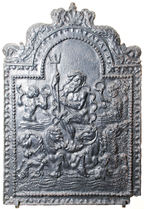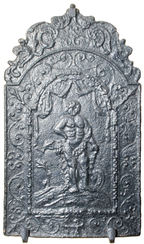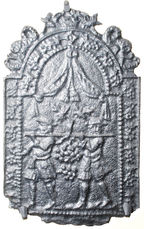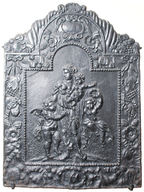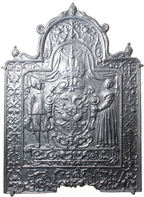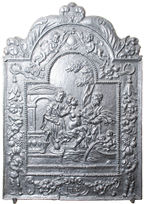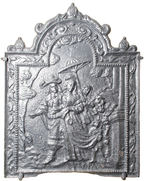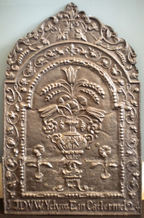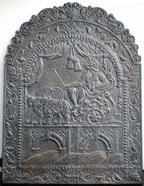-
536
Description: Arched rectangular shaped central panel with fillet and bead edging, Neptune/Poseidon, holding a trident in his right hand, sitting in a scallop shell drawn by four mythical sea horses, behind are two mermaids blowing horns; arched rectangular shaped border with ovolo egg and dart edging; above, two symmetrical dolphins with a clam shell between.
Notes: Typical type of fireback produced in Germany by Dutch pattern makers; the central panel was made separately for insertion into different borders; this border is a relatively simple type. Mitford collection, Petworth House.
Copies of this fireback are known.
- Decoration tags:
- 'Dutch' (shape)
- ovolo, egg and dart (edging)
- whole carved pattern
- pictorial
- biblical
- animals
- humans
Manufactured: in the mid- to late-17th century in the Siegerland area of Germany.
Current location: Petworth House, Petworth, West Sussex, England.
Museum number: NT/PET/M/90 (part of the National Trust museum group)
- Attached to series:
- 'Dutch' Miscellaneous Firebacks
- 'Dutch' Dolphin series
-
537
Description: Arched rectangular central panel with bead-and-pellet edging on a broad fillet; nude figure of a man standing on a mound, resting his left hand on a club, a plant to his right, and drapery swags above; arched rectangular border with symmetrical swirls; monogram centre bottom; on top, symmetrical, swirled foliage.
Notes: The figure is probably of Hercules. The depiction may have been adapted from the image of the divine hero in 'Speculum Romanae Magnificentiae', a collection of engravings dated 1573 by Antonio Lafreri after Philippe Thomassin. Mitford collection, Petworth House.
Copies of this fireback are known.
Inscription: SHR
- Decoration tags:
- 'Dutch' (shape)
- fillet (edging)
- whole carved pattern
- pictorial
- mythological
- monogram
- text
- humans
Manufactured: in the late-17th to early-18th century in England.
Current location: Petworth House, Petworth, West Sussex, England.
Museum number: NT/PET/M/91 (part of the National Trust museum group)
- Attached to series:
- SHR series
- British 'Dutch' style firebacks
-
539
Description: Arched rectangular central panel with bead-on-fillet edging; pictorial scene of two men in mid-17t century dress carrying a large bunch of grapes on a pole between them, above them drapery; arched rectangular border with fillet edging; cascade of flowers around arch and down sides; on top, central crown with descending serpents, an urn on each shoulder of the plate.
Notes: The scene depicts Joshua and Caleb returning from Canaan with a bunch of grapes (Numbers 13: 23-4). Mitford collection, Petworth House.
Manufactured: in the late-17th century possibly in the Siegerland area of Germany.
Current location: Petworth House, Petworth, West Sussex, England.
Museum number: NT/PET/M/94 (part of the National Trust museum group)
-
540
Description: Arched rectangular central panel with bead edging; pictorial scene of Venus sitting in a couch, with two other females, swathed in drapery, a putto holding an oval mirror to her left; Arched rectangular border with fillet edging; central cartouche at top, with festoons of fruit, flowers and leaves suspended on each side from ribbons supported by rings; at the bottom, swirled ribbon around an oval compartment bearing the inscription; on top, a central cartouche from which descend a cornucopia on each side of the arch.
Notes: The design is a copy of 'The Toilet of Venus' by Simon Vouet (c.1640); the image has been reversed. The inscription indicates the style of border; other firebacks with the same inscription have the same border; similar inscriptions (e.g. L7C and L8G) indicate different borders. Von den Driesch (p.517) illustrates the same central image within an L8G border. Mitford collection, Petworth House.
Copies of this fireback are known.
Inscription: L6C
- Decoration tags:
- 'Dutch' (shape)
- fillet (edging)
- whole carved pattern
- pictorial
- mythological
- text
- humans
Manufactured: in the mid- to late-17th century in the Siegerland area of Germany.
Current location: Petworth House, Petworth, West Sussex, England.
Museum number: NT/PET/M/95 (part of the National Trust museum group)
- Attached to series:
- 'Dutch' LC/G series
-
541
Description: Arched rectangular central panel with bead edging; pictorial scene of a female holding a small child, with two putti, one on each next side of her; arched rectangular border with fillet edging; central cartouche at top, with festoons of fruit, flowers and leaves suspended on each side from ribbons supported by rings; at the bottom, swirled ribbon around an oval compartment bearing the inscription; on top, a central cartouche from which descend a cornucopia on each side of the arch.
Notes: The allegorical figure of Charity; the inscription indicates the style of border; other firebacks with the same inscription have the same border; similar inscriptions (e.g. L7C and L8G) indicate different borders. Mitford collection, Petworth House.
Copies of this fireback are known.
Inscription: L6C
- Decoration tags:
- 'Dutch' (shape)
- fillet (edging)
- whole carved pattern
- pictorial
- allegorical
- text
- humans
Manufactured: in the mid- to late-17th century in the Siegerland area of Germany.
Current location: Petworth House, Petworth, West Sussex, England.
Museum number: NT/PET/M/96 (part of the National Trust museum group)
- Attached to series:
- 'Dutch' LC/G series
-
542
Description: Arched rectangular central panel with canted top corners and bead-on-fillet edging; elaborate central cartouche containing the double-headed eagle of the Holy Roman Emperor supported by male and female figures standing on a compartment with fillet edging, containing scrolled foliage and a central fleur-d-lys; above the central cartouche, the imperial crown and swagged drapery; arched rectangular border with canted top corners and cavetto-moulded edging; symmetrical arrangement of traceried foliage; on top, central oval casket with a serpent descending on each side of the arch to a further similar casket on each shoulder of the plate.
Notes: A variation of the standard 'Dutch' style of fireback. Mitford collection, Petworth House.
Manufactured: in the mid- to late-17th century possibly in the Siegerland area of Germany.
Current location: Petworth House, Petworth, West Sussex, England.
Museum number: NT/PET/M/97 (part of the National Trust museum group)
- Attached to series:
- 'Dutch' Miscellaneous Firebacks
- Foreign armorial firebacks
-
543
Description: Arched rectangular centrel panel with bead on fillet edging; pictorial scene of a seated naked female with two clothed male figures behind; in front is a pool with a fountain to the right, and platform with a vase of flowers to the left; behind, an archway and a tree; arched rectangular border with fillet edging; at the top of the arch a cartouche from which are suspended two ribbons, each held by a putto, from which cascade flowers and fruit, each lower part hung from a ring; two putti are on each side, one climbing on the suspended ribbon, the other at its foot; at the bottom, a cartouche containing the monogram between two clusters of flowers each suspended on a ribbon tied to a scroll; on top, two descending cornucopiae.
Notes: The scene is of Susanna and the Elders from the biblical Apocrypha. Mitford collection, Petworth House.
Copies of this fireback are known.
Inscription: HIS
Manufactured: in the mid- to late-17th century in the Siegerland area of Germany.
Current location: Petworth House, Petworth, West Sussex, England.
Museum number: NT/PET/M/98 (part of the National Trust museum group)
-
544
Description: Arched rectangular central panel with bead on fillet edging, pictorial representation of a man and woman walking, behind the woman a child holds her train and a young person carries a parasol; from behind a column on the right, a horse's head is visible, a tree stands to the left; arched rectabular border with cavetto-moulded edging; top centre, scallop shell from which descend undulating leaf fronds; on top, a pomegranate to which ascends a serpent on each side, with a further pomegranate on each shoulder of the plate.
Notes: The pictorial scene is based on an engraving c.1642 of Friedrich Wilhelm, Elector of Brandenburg, and his wife, Luise Henriette of Oranje-Nassau, by Mathias Czwiczek; one of series of firebacks depicting allegories of the four continents. Mitford collection, Petworth House.
Copies of this fireback are known.
Inscription: EVROPA
- Decoration tags:
- 'Dutch' (shape)
- cavetto (edging)
- whole carved pattern
- pictorial
- humans
Manufactured: in the mid- to late-17th century in the Siegerland area of Germany.
Current location: Petworth House, Petworth, West Sussex, England.
Museum number: NT/PET/M/99 (part of the National Trust museum group)
- Attached to series:
- 'Dutch' Miscellaneous Firebacks
- 'Dutch' Continents firebacks
-
885
Description: Arched rectangular shaped central panel, bead-and-pellet edging, narrow-necked, two-handled urn with flowers and wheat ears issuing therefrom, the vase resting on a wall with stone courses, against which are two small flowers in pots with a stool between; arched rectangular shaped border with fillet edging and symmetrical floral tendrils, a looped 'W' in each shoulder; on top, mirrored leaves, tendrils and wheat ears; inscription along bottom of border.
Notes: One of the two largest of six flower vase designs in this series (see also no. 858). All incorporate the looped 'W' motif which may be intended to identify the pattern maker. The casting is an amalgamation of parts of two firebacks of the same design, the bottom portion from an earlier casting than the top (reduction 2%). The inscription translates as 'God is our strength'.
Inscription: 17 DVW Ydyw Ein Cadernid 24
Manufactured: in 1724 in England.
Current location: not known.
- Attached to series:
- 1724 series
- British 'Dutch' style firebacks
- Welsh inscription series
-
886
Description: Arched rectangular central panel with ‘nutshell’ edging on a broad fillet; head-dressed figure, holding a sceptre in her right hand, sitting in a chariot drawn to the left by two armadillos; the whole upon a two-arched bridge with masonry, decorated keystones and spandrels, and waves beneath; above, swagged drapery with two tassels hanging from the centre; arched rectangular shaped border with fillet edging, with a symmetrical scrolled wire design; the monogram, SHR, bottom centre; above is a symmetrical design of scrolled floral tendrils.
Notes: The design is derived from a personification of America, one of a set of playing cards entitled 'Jeu de la Géographie', designed by Stefano della Bella (1677). Copies of this fireback were advertised in Bratt Colbran Ltd.'s (London) catalogue in the early-20th century.
Copies of this fireback are known.
Inscription: SHR
- Decoration tags:
- 'Dutch' (shape)
- fillet (edging)
- whole carved pattern
- pictorial
- architectural
- text
- animals
- humans
- objects
Manufactured: in the late-17th to early-18th century in England.
Current location: not known.
- Attached to series:
- SHR series
- British 'Dutch' style firebacks
